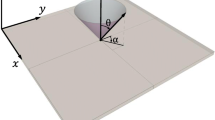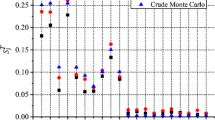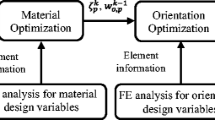Abstract
A double stage sequential optimization algorithm for finding the optimal fiber content and its distribution in solid composites, considering uncertain design parameters, is presented. In the first stage, the optimal amount of fiber in a Fiber Reinforced Composite (FRC) structure with uniformly distributed fibers is conducted in the framework of a Reliability Based Design Optimization (RBDO) problem. In the second stage, the fiber distribution optimization having the aim to more increase in structural reliability is performed by defining a fiber distribution function through a Non-Uniform Rational B-Spline (NURBS) surface. The output of stage 1(optimal fiber content for homogeneously distributed fibers) is considered as the input of stage 2. The output of stage 2 is Reliability Index (RI) of the structure with optimal fiber content and optimal fiber distribution. First order reliability method in order to approximate the limit state function and a homogenization approach, based on the assumption of random orientation of fibers in the matrix, are implemented. The proposed combined model is able to capture the role of available uncertainties in FRC structures through a computationally efficient algorithm using all sequential, NURBS and sensitivity based techniques. Performed case studies show as an increase in model uncertainties yields to structural unreliability. Moreover, when system unreliability increases fiber distribution optimization becomes more influential.















Similar content being viewed by others
References
Woo LY, Wansom S (2005) Characterizing fiber dispersion in cement composites using AC-Impedance Spectroscopy. Cem Concr Compos 27(6):627–636
Lee BY, Kim JK (2009) Quantitative evaluation technique of polyvinyl alcohol (PVA) fiber dispersion in engineered cementitious composites. Cem Concr Compos 31(6):408–417
Yan Z, Yuexin D (2009) The dispersion of SWCNTs treated by dispersing agents in glass fiber reinforced polymer composites. Compos Sci Tech 69(13):2115–2118
Wang C, Li K-Z (2008) Effect of carbon fiber dispersion on the mechanical properties of carbon fiber-reinforced cement-based composites. Mater Sci Eng 487(1-2):52–57
Scott DM (1997) Nondestructive analysis of fiber dispersion and loading. Compos Part A: Appl Sci Manuf 28(8):703–707
Dongyang W, Gao D (2008) X-ray ultramicroscopy: a new method for observation and measurement of filler dispersion in thermoplastic composites 68(1):178–185
Huang J, Haftka RT (2005) Optimization of fiber orientations near a hole for increased load-carrying capacity of composite laminates. Struct Multidisc Optim 30:335–341
Brighenti R (2005) Fiber distribution optimization in fiber-reinforced composites by a genetic algorithm. Compos Struct 71:1–15
Ghasemi H, Brighenti R, Zhuang X, Muthu J, Rabczuk T (2014) Optimization of fiber distribution in fiber reinforced composite by using NURBS functions. Comput Mater Sci 83:463–473
Di Sciuva M, Lomario D (2003) A comparison between Monte Carlo and FORMs in calculating the reliability of a composite structure. Compos Struct 59(1):155–62
Thanedar PB, Chamis CC (1995) Reliability considerations in composite laminates tailoring. Comput Struct 54(1):131–139
Jiang C, Han X, Liu GP (2008) Uncertain optimization of composite laminated plates using a nonlinear interval number programming method. Comput Struct 86:1696–1703
Gomes HM, Awruch AM (2011) Reliability based optimization of laminated composite structures using genetic algorithms and Artificial Neural Networks. Struct Saf 33:186–195
Antonio CC, Hoffbauer LN (2009) An approach for reliability-based robust design optimization of angle-ply composites. Compos Struct 90:53–59
Noh YJ, Kang YJ (2013) Reliability-based design optimization of volume fraction distribution in functionally graded composites. Comp Mater Sci 69:435–442
Brighenti R (2004) Optimum patch repair shapes for cracked members. Int J Mech Mat Des 1(4):365–381
Brighenti R, Carpinteri A, Vantadori S (2006) Genetic algorithm applied to optimization of patch repairs for cracked plates. Comp Meth App Mech Eng 1960:466–475
Brighenti R (2007) Patch repair design optimization for fracture and fatigue improvements of cracked plates. J Sol Struct 44(3-4):1115–1131
Kulasegaram S, Karihaloo BL, Ghanbari A (2011) Modeling the flow of self-compacting concrete. Int J Numer Anal Methods Geomech 35(6):713–723. ISSN 0363-9061 10.1002/nag924
Kulasegaram S, Karihaloo BL (2012) Fibre-reinforced, self-compacting concrete flow modeled by smooth particle hydrodynamics. Proc ICE Eng Comput Mech 166(1):22–31. ISSN 1755- 0777 10.1680/eacm.11.00004
Hashin Z (1962) The elastic moduli of heterogeneous materials. J Appl Mech 29:143–150
Hashin Z, Shtrikman S (1963) A variational approach to the theory of elastic behavior of multiphase materials. J Mech Phys Solids 11:127–140
Paulm B (1960) Prediction of elastic constants of multiphase materials. Trans Metall Soc AIME:36–41
Hill R (1965) A self-consistent mechanics of composite materials. J Mech Phys Solids 13:213–222
Mori T, Tanaka K (1973) Average stress in matrix and average elastic energy of materials with mis-fitting inclusions. Acta Metal 21:571–583
Brighenti R (2012) A micromechanical model and reinforcing distribution optimization approach for fiber-reinforced materials. In: Ching Q G (ed) Fiber Reinforced Composites. Nova Science Publishers Inc., Hauppauge, pp 527–569
Brighenti R (2004) A mechanical model for fiber reinforced composite materials with elasto-plastic matrix and interface debonding. Int J Comput Mater Sci 29:475–493
Brighenti R (2004) Numerical modeling of the fatigue behavior of fiber-reinforced composites. Int J Compos Part B: Eng 35(3):197–210
Brighenti R, Scorza D (2012) A micro-mechanical model for statistically unidirectional and randomly distributed fiber-reinforced solids. Math Mech Solids 17(8):876–893
Ditlevsen O, Madsen H (1996) Structural reliability methods. Wiley, UK
Hasofer AM, Lind N (1974) An exact and invariant first-order reliability format. J Eng Mech ASCE 100:111–121
Chiachio M, Chiachio J, Rus G (2012) Reliability in composites - a selective review and survey of current development. Compos 43(B):902–913
Zhao Y-G, Ono Tetsuro (1999) A general procedure for first/second-order reliability method (FORM/SORM). Struct Saf 21:95–112
Kiureghian AD (2006) Structural reliability software at the university of California, Berkeley. Struct Saf 28:44–67
Cottrell JA, Hughes TJR, Bazilevs Y (2009) Isogeometric Analysis towards integration of CAD and FEA. Wiley, UK
Zhou M, Rozvany GIN (1991) The COC algorithm part II: topological, geometry and generalized shape optimization. Comput Methods Appl Mech Eng 89:197–224
Togan V, Daloglu A (2006) Reliability and reliability based design optimization. Turkish. J Eng Env Sci 30:237–249
Acknowledgments
This work was supported partially by Marie Curie Actions under the grant IRSES-MULTIFRAC and German federal ministry of education and research under the grant BMBF SUA 10/042. Nachwuchsförderprogramm of Ernst Abbe foundation, the National Basic Research Program of China (973 Program: 2011CB013800), Program for Changjiang Scholars and Innovative Research Team in University (PCSIRT, IRT1029), Pujiang Program (12PJ1409100) and the research support provided by the Italian Ministry for University and Technological and Scientific Research (MIUR) are also acknowledged.
Author information
Authors and Affiliations
Corresponding authors
Rights and permissions
About this article
Cite this article
Ghasemi, H., Brighenti, R., Zhuang, X. et al. Optimal fiber content and distribution in fiber-reinforced solids using a reliability and NURBS based sequential optimization approach. Struct Multidisc Optim 51, 99–112 (2015). https://doi.org/10.1007/s00158-014-1114-y
Received:
Revised:
Accepted:
Published:
Issue Date:
DOI: https://doi.org/10.1007/s00158-014-1114-y




